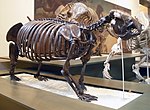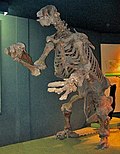small island in Panama. The record of a tamandua from Cozumel, off Mexico, was probably in error. The genera of Caribbean pilosans are classified as follows...
17 KB (1,958 words) - 23:48, 17 August 2023
exclusively so. Some other pilosans are still found on islands along the margin of the Caribbean. The order Eulipotyphla includes the hedgehogs, gymnures, shrews...
28 KB (3,704 words) - 11:47, 4 February 2024
Megalocnidae (category Mammals of the Caribbean)
Imagocnus †I. zazae Early Miocene of Cuba For other sloth taxa of the Caribbean, see Pilosans of the Caribbean. The following sloth family phylogenetic...
16 KB (1,620 words) - 01:44, 10 July 2024
of eulipotyphlans of the Caribbean Pilosans of the Caribbean Rodents of the Caribbean Sealife Caribbean hermit crab Caribbean Queen Conch Caribbean reef...
17 KB (1,115 words) - 12:03, 28 July 2024
Megalocnus (category Mammals of the Caribbean)
view of AMNH mount in left foreground Pilosans of the Caribbean Couto, C. D. P. (1967). Pleistocene edentates of the West Indies. American Museum novitates;...
13 KB (1,386 words) - 02:02, 6 July 2024
Pygmy three-toed sloth (category Mammals of the Caribbean)
documented. Pilosans of the Caribbean Voirin, B.; Smith, D.; Chiarello, A.; Moraes-Barros, N. (2014). "Bradypus pygmaeus". IUCN Red List of Threatened...
18 KB (2,118 words) - 06:26, 15 August 2024
Acratocnus (category Mammals of the Caribbean)
Paleontology portal Prehistoric mammals portal Pilosans of the Caribbean Anthony, H. E. 1918. The indigenous land mammals of Porto Rico, living and extinct. Mem...
12 KB (1,148 words) - 03:54, 19 July 2024
Neocnus (category Mammals of the Caribbean)
the indigenous peoples of the Caribbean for its pelt and meat. Neocnus is suspected of having been semi-arboreal. Paleontology portal Pilosans of the...
3 KB (280 words) - 17:07, 3 April 2024
Imagocnus (category Miocene mammals of North America)
though the genera Megalocnus and Parocnus, other ground sloths, are its most likely relatives. Paleontology portal Prehistoric mammals portal Pilosans of the...
3 KB (225 words) - 18:13, 30 December 2023
Peopling of the Americas European colonization of the Americas Fossil primates of South America and the Caribbean Pilosans of the Caribbean Rodents of the Caribbean...
70 KB (2,715 words) - 07:39, 12 July 2024
Anteater (redirect from Evolution of anteaters)
endemic to the New World, where they are found on the mainland from southern Mexico to northern Argentina, as well as some of the Caribbean islands. Like...
39 KB (4,538 words) - 21:37, 27 May 2024
2019 in paleomammalogy (category CS1 maint: DOI inactive as of April 2024)
Beatty (2019). "Fossil Sirenia of the West Atlantic and Caribbean region. XII. Stegosiren macei, gen. et sp. nov". Journal of Vertebrate Paleontology. 39...
329 KB (34,199 words) - 03:18, 27 June 2024
Megatheriidae (category Neogene mammals of South America)
family of extinct ground sloths that lived from approximately 23 mya—11,000 years ago. Megatheriids appeared during the Late Oligocene (Deseadan in the SALMA...
10 KB (535 words) - 05:17, 13 August 2024
Sloth (redirect from Evolution of sloths)
led to oceanic dispersal of pilosans to the Greater Antilles by the Oligocene, and that the megalonychid Pliometanastes and the mylodontid Thinobadistes...
50 KB (5,420 words) - 09:47, 15 August 2024
Scelidotheriidae is a family of extinct ground sloths within the order Pilosa, suborder Folivora and superfamily Mylodontoidea, related to the other extinct mylodontoid...
9 KB (726 words) - 16:18, 21 June 2024
2023 in paleomammalogy (section Pilosans)
the Caribbean–Pacific water interchange continued during the shallowing of the Central American Seaway in the Miocene. Fossil material of a member of Chaeomysticeti...
348 KB (35,169 words) - 08:10, 24 July 2024
Mylodontidae (category Neogene mammals of South America)
Mylodontidae is a family of extinct South American and North American ground sloths within the suborder Folivora of order Pilosa, living from around 23...
12 KB (1,033 words) - 21:20, 3 July 2024
Largest prehistoric animals (redirect from List of largest prehistoric carnivorans)
needed] The largest known pilosan is Eremotherium, a ground sloth with an estimated weight of up to 6.55 t (7.22 short tons) and a length of up to 6 m...
394 KB (40,071 words) - 05:35, 19 August 2024
includes the Caribbean sloths Neocnus, Parocnus Megalocnus and Arcatocnus which have been placed in the separate family Megalocnidae, well as the two toed...
17 KB (1,524 words) - 21:35, 3 July 2024
Parocnus (category Mammals of the Caribbean)
of sloth native to Cuba and Hispaniola, belonging to the family Megalocnidae. It was a terrestrial ground sloth, being the second largest Caribbean sloth...
3 KB (295 words) - 03:30, 10 July 2024
Lestodon (category Pliocene mammals of South America)
extinct genus of giant ground sloth native to South America during the Pleistocene epoch. Its fossil remains have been primarily been found in the Pampas and...
25 KB (2,619 words) - 16:08, 13 August 2024
Diabolotherium (category Pleistocene mammals of South America)
similar to extinct sloths from the Caribbean. Fossils of the genus were found at the coastal Piedra Escrita site and the Andean Casa del Diablo cave. Diabolotherium...
13 KB (1,779 words) - 08:23, 26 June 2024
Nothrotheriidae (category Neogene mammals of South America)
predators, like those of larger anteaters today. During the late Miocene and Pliocene, the sloth genus Thalassocnus of the west coast of South America became...
15 KB (907 words) - 03:39, 19 August 2024
Mylodon (category Pleistocene mammals of South America)
two-toed sloths were close to Caribbean sloths and Megalonyx, now regarded as representing two separate and distant branches of the sloth evolutionary tree...
79 KB (9,940 words) - 21:42, 3 July 2024
Megathericulus (category Miocene mammals of South America)
drained north into the Caribbean Sea. As the Pebas megawetland, they represent the forerunner of today's Amazon rainforest. The lower jaw find itself was...
19 KB (2,526 words) - 18:15, 30 December 2023
Baraguatherium (category Miocene mammals of South America)
in the boundary of the Caribbean to the South American Plate. An almost complete depositional sequence has been preserved here, ranging from the Eocene...
16 KB (1,884 words) - 00:59, 1 January 2024
Miocnus (category Pleistocene Caribbean)
Miocnus is an extinct genus of ground sloths of the family Megalocnidae endemic to Cuba during the Pleistocene and very early Holocene epochs, living from...
4 KB (252 words) - 17:50, 10 July 2024
Ahytherium (category Pleistocene mammals of South America)
another consists of the North American forms Megalonyx and Pliometanastes (here, since based on skeletal features, also Caribbean sloths such as Megalocnus...
12 KB (1,164 words) - 09:54, 1 April 2024
Pseudoprepotherium (category Miocene mammals of South America)
rivers connected to the Caribbean. It can now be described as "the Pebas mega wetland". Some of the finds, however, are assigned to the species Pseudoprepotherium...
25 KB (3,079 words) - 04:02, 29 April 2024





















